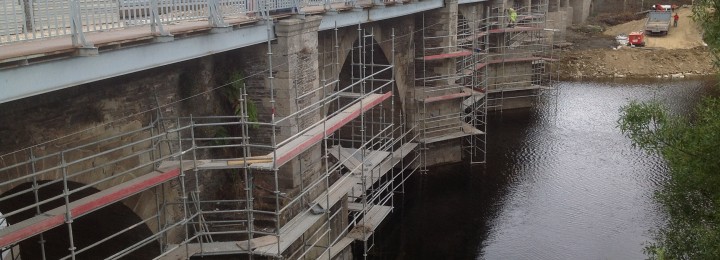01/09/2013
The refurbishment of the Roman Bridge in Lugo implied the use of a high-precision scanner laser for the structure

Misturas will conclude in the next days a work which used next-generation technology for the recovery of this emblematic infrastructure of the capital of Lugo.
Misturas will conclude in the next days the refurbishment of the Roman Bridge of Lugo, a project for which it used the modern prototype of a three-dimensional scanner laser which enables it to document with a high precision the whole of the infrastructure, including the ashlars walls and foundations of the columns which were exposed on drying River Miño for the execution of the works. The works served to know the scope of work and precision of the equipment of the so-called Sitegi Project, an initiative fostered by Universidad de Vigo and a group of companies from Galicia, among which Misturas is to be found, for the inspection of the infrastructures, to the sole purpose of optimizing decision-taking on the need for carrying out interventions on them. In short, Misturas used this prototype to control several aspects of the refurbishing works. On the one hand, it carried out the so-referenced scanning using a next-generation mobile scanner laser included in the mobile unit for inspection developed for this project. Therefore, the foundations for columns 2, 3 and 4, of a Roman origin, were studied since they laid exposed when the river was dried by building a provisional cofferdam on the river bed. On the other hand, the filling of the bridge was inspected with a geo-radar, which included the channels of different urban utilities, such as those of drinking water supply, street lighting, low voltage lines and spare spaces planned for future channelling, to prevent the impact of such on the landscape. This pieces of equipment resulted especially useful in the finding of buried elements as a result of several concrete interventions, such as the operations for the maintenance of the drinking water supply service of the A Ponte neighbourhood during a phase of the works, when a provisional piping system was placed, and the definite installation of the network which was to be placed inside the bridge once the works were finished. The refurbishing works of the Roman Bridge contemplated the elimination of the metallic structure of the sideways and of the existing reinforced concrete slabs and pavement which was substituted by slate. New parapets were also built in stone and its ground surface line was modified, achieving a warped aspect similar to that it had before a reconditioning introduced in 1893 by Engineer Godofredo A. Cascos, looking at present much more similar to the Roman original. The Sitegi Project was co-financed by Feder, Fondo Europeo de Desarrollo Regional, as part of the Programa Operativo Fondo Tecnológico 2007-2013, and by the CDTI, Centro para el Desarrollo Tecnológico Industrial. The following companies from Galicia participate in this joint research with Misturas: Extraco, Insitu Ingeniería, Enmacosa and Lógica, as well as Grupo de Investigación TF1 of the University of Vigo. The project, in the middle of the three years foreseen for its execution, has a €3.7 million budget.
